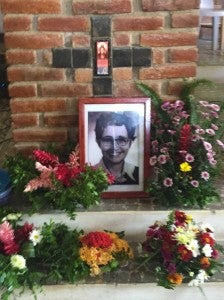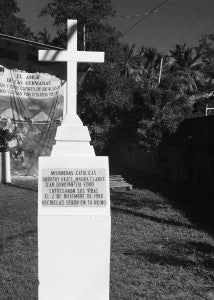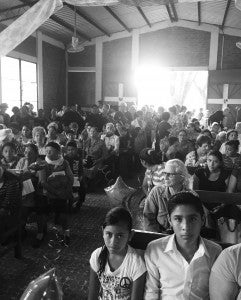35 Years After El Salvador’s Church Martyrs
 I just returned from a mission in El Salvador to commemorate the 35th anniversary of Sister Maura Clarke’s, M.M., death. On December, 2, 1980, Maura was kidnapped, raped and brutally murdered by members of the El Salvadoran security forces along with Sister Ita Ford, M.M, Sister Dorothy Kazel and lay missionary worker Jean Donovan. Maura was my husband’s aunt. I had heard about her good works and humble life for the 22 years of my marriage but it wasn’t until I walked in her shoes, however briefly, that I began to understand her devotion to serving the poor.
I just returned from a mission in El Salvador to commemorate the 35th anniversary of Sister Maura Clarke’s, M.M., death. On December, 2, 1980, Maura was kidnapped, raped and brutally murdered by members of the El Salvadoran security forces along with Sister Ita Ford, M.M, Sister Dorothy Kazel and lay missionary worker Jean Donovan. Maura was my husband’s aunt. I had heard about her good works and humble life for the 22 years of my marriage but it wasn’t until I walked in her shoes, however briefly, that I began to understand her devotion to serving the poor.
The first day we set off to the site where the bodies were discovered. Seeing the procession of both locals and religious people, totaling over 150 in number, from various cities in the U.S. as well as other parts of Central and South America was overwhelming. The love and admiration expressed by the gathered community was inspirational. Seeing the modest monument and humble chapel was further evidence of their collective appreciation for Maura, Ita, Dorothy and Jean. Many people shared intimate stories that shed new light for me on the incredible person Maura was. We met someone who named their daughter after Maura, someone who explained how Maura saved her life and countless others who just cried at the memory of her spirit. The beautiful mass with the lively Salvadoran music and the gathered clergy on the altar juxtaposed the solemn ground where tragedy lay.
 The following day we drove to Chalatenango, a small town several hours outside of San Salvador. We headed to the cathedral and found it locked but ventured behind to find the place where Maura lived. My mother in-law, now 80, Maura’s younger sister, was determined to show us where Maura made her home while in El Salvador. We traversed fresh cement and peeked inside. She described the room, full of bags of rice and beans used to feed the poor. The simplicity with which she was at ease doing her work day in and day out reminded me of what truly mattered. Her room was behind a metal door along an exterior hallway. It seemed at least she had her own space to retreat to after her day. We continued on through interior doorways that led to a small courtyard and into another space where we found the head priest of the church. We introduced ourselves and, of course, he was honored to meet Maura’s family and took us back to the beautiful cathedral. It was peaceful that day and hard to imagine the day of the funeral- with tanks out front and a packed house and streets. To be in the town where Maura lived and worked and to be praying in the church where Maura prayed was an emotional experience that is hard to describe.
The following day we drove to Chalatenango, a small town several hours outside of San Salvador. We headed to the cathedral and found it locked but ventured behind to find the place where Maura lived. My mother in-law, now 80, Maura’s younger sister, was determined to show us where Maura made her home while in El Salvador. We traversed fresh cement and peeked inside. She described the room, full of bags of rice and beans used to feed the poor. The simplicity with which she was at ease doing her work day in and day out reminded me of what truly mattered. Her room was behind a metal door along an exterior hallway. It seemed at least she had her own space to retreat to after her day. We continued on through interior doorways that led to a small courtyard and into another space where we found the head priest of the church. We introduced ourselves and, of course, he was honored to meet Maura’s family and took us back to the beautiful cathedral. It was peaceful that day and hard to imagine the day of the funeral- with tanks out front and a packed house and streets. To be in the town where Maura lived and worked and to be praying in the church where Maura prayed was an emotional experience that is hard to describe.
 The town was much as my in-laws remembered except there is now a Pollo Campero, a café, and a spa. Some signs of progress but still same signs of poverty. After, we headed to the cemetery for the service. There was a smaller group than the day before, mainly the SHARE group and some locals that were hosting SHARE that night. It was a further time of reflection of the good works and deep faith of Maura, Ita and Karla. Claire White, daughter of then Ambassador White, spoke and said while many have said this tragedy cost her father his career he always believed this tragedy provided him the platform to stand for justice and truth.
The town was much as my in-laws remembered except there is now a Pollo Campero, a café, and a spa. Some signs of progress but still same signs of poverty. After, we headed to the cemetery for the service. There was a smaller group than the day before, mainly the SHARE group and some locals that were hosting SHARE that night. It was a further time of reflection of the good works and deep faith of Maura, Ita and Karla. Claire White, daughter of then Ambassador White, spoke and said while many have said this tragedy cost her father his career he always believed this tragedy provided him the platform to stand for justice and truth.
What does it mean to give one’s life for others? Does it mean you have to actually give your life, as in no longer have a breath or does it mean to devote your life to helping others? In Maura’s case and in the case of those other 3 women, it meant both. In this time of reflection and prayer on the first days of Advent I struggle with how I can do just a little bit to walk the walk of Sr. Maura Clarke. I will never be as good or as strong as she was but isn’t the point to try just a little bit harder to give of yourself to others? As members of the Georgetown community our call to faith and pursuit of justice must be part of our everyday lives. If we don’t start now, then when?
Written by Terri Austin Keogh, (F’89)
A video expose was released by the New York Times on November 10, 2014, concerning the murder of Sisters Clark, Ford, Kazel, and lay worker Donovan, and explores the impact of American politics on the case. That video is online and available here .